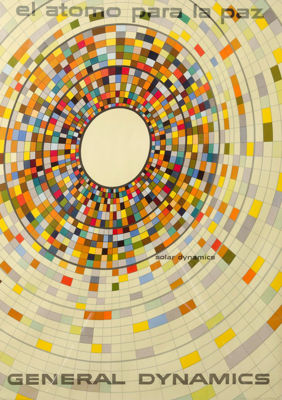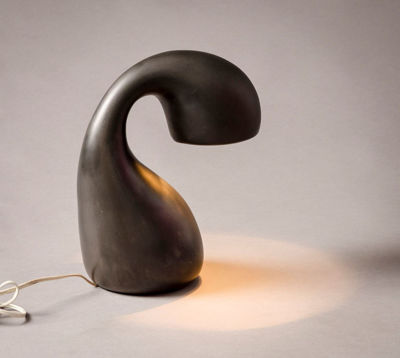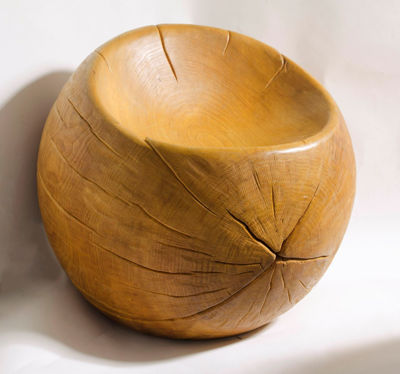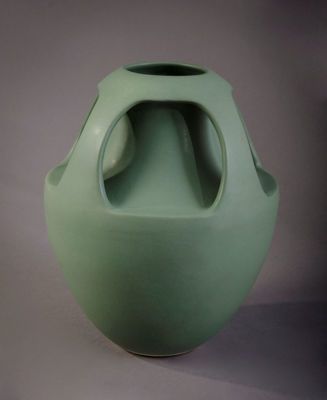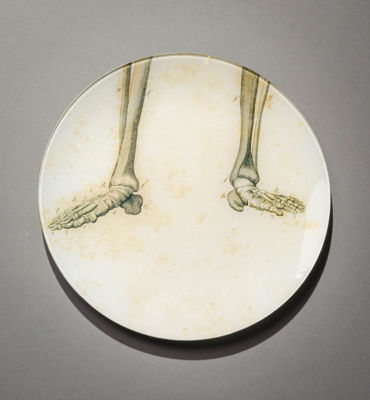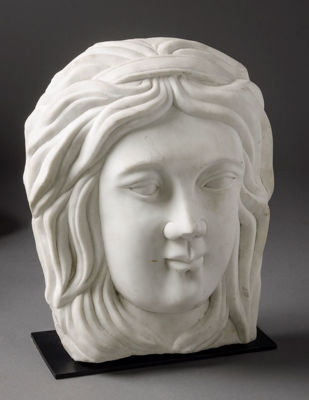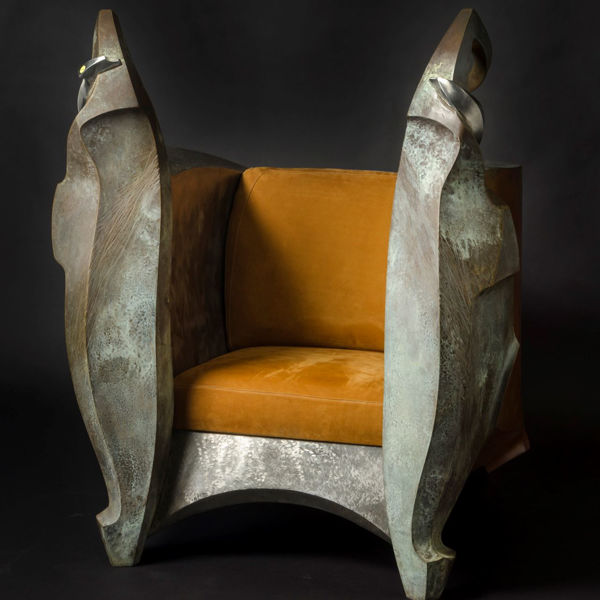Decorative and Design
Title: Egret in Black Basalt
Egret from the celebrated English ceramic firm, modelled by Ernest Light and completed in black basalt with distinctive glass eyes in the early 20th century. Josiah Wedgwood introduced into production a black stoneware body in 1768. The first trials for Wedgwood's new black body had begun by July 1766, even before the move to Etruria. By September 1767 his experiments were at an advanced stage, ready for production, and less than twelve months later black basalt wares were on the market. He called it ‘Black Basaltes'; we know it as black basalt. Made from reddish-brown clay which burned black in firing, this ceramic body was superior in its appearance to the local 'Egyptian Black' wares produced in the area prior to that date. Provenance: Property of the Saint Louis Art Museum, Sold to benefit the acquisition fund.
Title: El Atomo Para la Paz
A Swiss-born artist, Erik Nitsche bucked the popular Art Deco design trend of the 1920’s in favor of the more orderly, rational Bauhaus style. He moved to America in the early 1930’s to avoid the impending war in Europe. The Bauhaus style attracted attention in New York, and after a stint with fashion and decorative magazine spreads, he moved on to become the art director of Air Technology and Air News magazines. This technical topic suited him, and he worked with a large number of clients. Ever restless, Nitsche moved on again to work with General Dynamics Corporation. GDC was founded in 1899 and is an multinational aerospace and defense corporation. At the time of Nitsche’s work with them, they were working on developing submarine technology. General Dynamics hired Nitsche as art director in 1955 with the hopes that he could use his design skills to convey the message that atomic energy and the company were purveyors of peace instead of destruction. Nitsche was given total freedom to rebrand the company. Between 1955-1960 Nitsche built a total corporate identity for GDC. Poetic interpretations of atomic energy and their products were printed onto posters, postcards, brochures and even a 420-page book that detailed the history of the company. This particular piece is from the General Dynamic “Atoms for Peace” series printed in 1956.
Title: Elephant in Black Basalt
Elephant from the celebrated English ceramic firm, modelled by Ernest Light and completed in black basalt with distinctive glass eyes in the early 20th century. Josiah Wedgwood introduced into production a black stoneware body in 1768. The first trials for Wedgwood's new black body had begun by July 1766, even before the move to Etruria. By September 1767 his experiments were at an advanced stage, ready for production, and less than twelve months later black basalt wares were on the market. He called it ‘Black Basaltes'; we know it as black basalt. Made from an umber clay which burned black in firing, this ceramic body was superior in its appearance to the local 'Egyptian Black' wares produced in the area prior to that date.
Title: Eliza's Dark Little Question Light
Named for the artist's curious first child, designed as part of the interior of the Herzblut St. Pauli, Hamburg, Germany.
Title: Embryo Lounge Chair
Perhaps the most iconic piece by designer Marc Newson, and a 20th century classic — the ‘Embryo’ chair design was first commissioned for the 1988 Powerhouse Museum ‘Take a Seat’ exhibition in Sydney. Newson frequently refers to the piece as one of the first to fully flesh out his now distinct style, the dissolution of sharp edges leaving a biomorphic and boldly extraterrestrial form. Three legs of chromed steel support the softly padded polyurethane foam body, the single piece covered in a neoprene fabric (more commonly used in wetsuits) to give a comfortable, fleshy contact. Embryo Chair | EC/1 Manufacturer Cappellini Designer Marc Newson Launched in 1988 Architonic id 1003759 Armchair with three legs, structure in chromed steel and padding in moulded polyurethane foam, covered with bi-elastic fixed fabric. cm. 80 x 85 x 45/80 h. inch 31,50 x 33,50 x 17,75/31,50 h. Product group: Seating Lounge area / Waiting room Armchairs Lounge chairs open base open base without armrests without armrests with seat and backrest upholstered with seat and backrest upholstered with base in steel with base in steel with 3-leg base
Title: Enamel Decorated Vase
Rare faceted ceramic vase enamel-decorated with carnations and butterflies.
Title: Enameled Black Basalt Vase Small
A black basalt vase competed in the 19th century and in the Portland vase silhouette with floral decoration often used by Wedgwood towards the latter part of his career. Josiah Wedgwood introduced into production a black stoneware body in 1768. The first trials for Wedgwood's new black body had begun by July 1766, even before the move to Etruria. By September 1767 his experiments were at an advanced stage, ready for production, and less than twelve months later black basalt wares were on the market. He called it ‘Black Basaltes'; we know it as black basalt. Made from reddish-brown clay which burned black in firing, this ceramic body was superior in its appearance to the local 'Egyptian Black' wares produced in the area prior to that date. It was originally designed as a smooth surface for holding decorative application with inspiration from classical “Etruscan” (Greek or Italian) vessels set across a number of private English collections, but the popularity of the style has meant a wide application of ornamental designs over the companies history,
Title: Erotic Devil and Angel Ball Clock
The devil does not run when wound. Light surface scratching a minor dents throughout consistent with use. Item 173: Arabic numbers, wound by lever at top, set by pressing button right of lever and winding, painted face, devil, woman in cauldron, woman's arm has erotic animation that is automatic and continuous after winding, face signed, "A..." (?), viewable works, front and back open at notches, works engraved, "Hahn Marke" Father Time Antiques,Chicago, IL, 1998
Title: Etagere with Barleytwist posts
English Etagere with Barleytwist Posts, early 20th century, single drawer with Hepplewhite-style hardware
Title: Face Desk Clock
Clock runs when wound. Wear and discoloration, expected with age. Teeth/mouth move.


